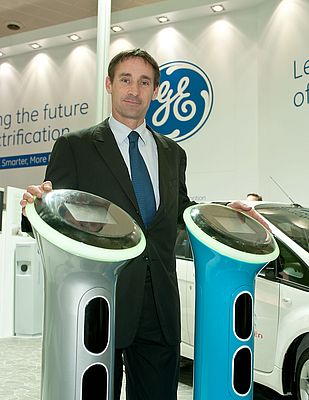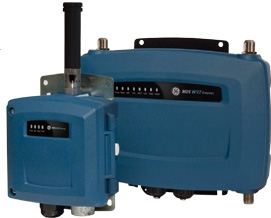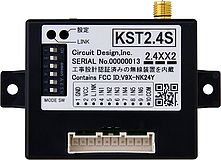IEN: Mr Johnstone, for all those who are not so familiar with the complex General Electric organogram: Could you please outline your company’s structure, and put GE Energy – Industrial Solutions in that context?
Johnstone: Within GE, we are part of the GE Energy, which, with over 40 billion US Dollars in turnover last year, is the largest business within the GE – the others being Health Care, Aviation, Transportation, Home & Business and Capital.
GE Energy deals with everything from exploration, fuel sources - whether it’s oil or gas exploration and have a major turbine business, that covers all ranges and sizes of turbines. We can provide transmission and distribution, and then the entire demand side; from electrical usage from industrial users and commercial buildings, all the way down to residential buildings.
Our role within that structure is, for lack of a better term, the electrification side of it: the protection and the control of the distribution and energy usage. Within that, Industrial Solutions is a 4 billion dollar entity within the 40 billion dollar turnover of GE Energy.
IEN: ‘Smart Efficiency’ is this year’s hot topic at Hannover Messe. Is this subject reflected in the products and solutions that you are exhibiting here in Hannover?
Johnstone: Yes. If you think about the big challenges our customers have today, firstly it’s the increased demand for electricity. No matter what estimates you look at, somewhere within the next 15 to 20 years, the forecast is for electricity demand to double globally, and Europe is a big part of that.
Here in Europe we’re dealing with an infrastructure that in many cases is 100 years old, and aging. So the question is: how do you optimize that, and at the same time, how do you build new sources in renewables into the grid efficiently?
Secondly we’re doing that in an era where budgets are restricted in the best case, and in the worst case shrinking. So we think it’s important to understand those customer problems independently. Our view is: how do we design our solutions in order to make them smarter, cleaner and more efficient to help our customers solve those problems? Each of the products we display here and we’ve invested in during the last couple of years follow those themes of smarter, cleaner more efficient.
IEN: Did you notice a bigger interest in those renewable products here in Hannover, because of the events currently happening in Japan?
Johnstone: We’ve become more present with our product investments in renewables – whether it’s in e-mobility, photovoltaics, or wind energy - I think the renewable trends in general have gone up significantly. And in terms of the events in Japan, it’s hard to gauge, I think there is some short-term emotional response to that, but I’m not sure how it will generally impact the energy mix going forward.
IEN: Taking your electric vehicle charger WattStation as one example for a new product you are introducing here in Hannover: How long do you think will it take until electric automobiles will be established as a mass product for transportation?
Johnstone: The way we look at it – and again it comes down to one of the customer challenges we’re seeing, our utility customers, our commercial customers, and even in many cases residential customers – we see a trend towards the need for cleaner energy. And this is all about lower emissions. We’ve developed an industry-leading product in the WattStation, and, most importantly, the infrastructure around it, the two-way communication capability, the protection of the vehicle, the services around it, so that clearly our customers see an advantage to use those solutions in the future.
The prediction of how this market will grow: we think at some point it will accelerate significantly, but there are varying degrees. Recently we saw reports that that by 2015/ 2016 there would be 3 million electrical vehicles on the road globally, of which a significant number will be in Europe, requiring about 2 to 2.2 charging stations per vehicle, but there is also a need for infrastructure. So we think that’s an opportunity. Whether it’s accurate or not time will tell, but clearly the trend is going that way.
IEN: Is there a kind of cooperation between, let’s say, car manufacturers and companies that provide the infrastructure on a European or even global level?
Johnstone: I haven’t seen anything on a global level. We are keeping our partnerships open, and we are talking to numerous players, both globally and on a European level. We think it’s critical to the customer offer that there is some kind of cooperation there, but at the same time the innovation has to happen independently as well.
Taking our own company GE as an example, we can not only provide the infrastructure that we have as a business, but then GE fleet operates our global fleet to GE vehicles and for partners around the world, so there’s a lot of cooperation there on how we develop that, and move our fleet more towards electrical vehicles. Our Chairman and CEO Jeffrey Immelt announced at the end of last year that we will be buying 25,000 electrical vehicles in the upcoming years. And, as we do this with our partners, we can finance that with our GE Finance entity. So there’s a lot of cooperation going on.
IEN: The charging of a vehicle takes between 4 and 8 hours. Does that mean that every owner of such a vehicle will have to install a WattStation at home?
Johnstone: It depends on the individual use and the travel time, battery technology and the range of the electrical vehicles available.
We’re looking at incorporating an infrastructure and a set of technology that will accelerate the charging time, potentially from up to 8 hours, without a charger to under one and we’re pretty confident that we will achieve that goal in the near future.
It may not be as needed as people think it is, it more of an option and a personal choice.
IEN: Your focus regarding that product was not only on functionality, but also on form…
Johnstone: Yes, as we evolve and position ourselves as an innovation and technology leader, the form of a product like the WattStation, given the visible appearance and the needs again - whether it’s a municipality, a parking garage, or a home owner habitation - we think the style is important. And we certainly invested a lot and spent a lot of time, and found one of the best designers in the industry to provide us with that. So we think it’s critical, and it’s different to some of our products which maybe don’t have this external visibility.
IEN: With respect to the reduction of carbon dioxide emissions caused by industrial motors, the EU Directive 2005/32/EC will take effect as of June 16 this year, which obliges all manufacturers of motors from 0.75kW up to 375kW to sell motors in efficiency class IE2 minimum. Your range of industrial motors is debuting here at the show. What are your solutions here?
Johnstone: The Ultra XT, which is the new ultra-efficient motor we have just launched, will meet those requirements. It’s a very competitive, efficient low-voltage motor. With regard to a certain range of usage and application, it can save the equivalent of two households of electricity per year. So we are very confident that this product will be competitive.
IEN: According to your experience, is energy efficiency of electric motors primarily a European concern, or is it also relevant in Africa, the Middle East, Asia or GE’s market, the U.S.?
Johnstone: We see it as a global trend and a global need. Obviously, there are some regional differences, but I was just in South Africa four or five weeks ago, and the biggest concerns that the mining companies have are energy costs and employment. Regarding energy costs, obviously the first thing they want to talk about is motors. And certainly, in the US market, for which many of our products were developed as well, it’s a major concern. With rising energy costs, any heavy industry user has that at the top of his agenda.
IEN: The nuclear disaster in Japan has put even stronger emphasis on renewable energies, that also play an important role here in Hannover. Does this trend already reflect in an increasing demand of your products in that area?
Johnstone: Again, in the short term, we haven’t seen anything substantial to comment on that. We think the energy mix will change, and certainly events like this have an impact, but we are more focused on the long term, and being able to provide our customers with solutions, whether they need a wind or gas turbine, a solar or a nuclear solution. And that’s where we think the strength of GE is, to be able to play in those areas and offer solutions.
IEN: Do you expect a much faster proliferation of wind and solar energy farms, as well as the required power distribution infrastructure now?
Johnstone: We’ve already seen significant growth in the global wind and solar markets. I read recently that regarding solar energy, there are 17 Gigawatts of installed capacity last year. That’s a huge amount by anyone’s accounts. But it’s not only the aspect of renewable energy. You can also save a lot of energy by using cleaner, more efficient products, and you can get a lot more overall efficiency by using the existing electricity more efficiently.
We see a significant opportunity in wind and solar. They continue to grow, obviously also due to the subsidies. We can provide these safer, cleaner solutions for wind towers and photovoltaic installations, for building automation and efficiency. That’s where we see the advantage that GE can bring to the customers.
IEN: With HabiTEQ you offer a product portfolio for smart building automation, which also contributes to the mega topic ‘Energy Efficiency’. In public places such as hospitals or big office buildings, the smart or intelligent building is already a hot issue. For the private home owner, it is still kind of futuristic. Will this change within the next 2 or 3 years?
Johnstone: The HabiTEQ offering is a perfect example of a smarter product. You asked earlier how it fits into this theme. It’s something that we realized our customers, who are providing protection and distribution equipment for homes and commercial buildings, needed.
Partially legislated, partially because of the need for buildings, from both a retrofit standpoint and new construction, to offer more of an efficiency package in addition to the protection.
We started investing heavily three or four years ago, and now we have a whole suite of home and building automation products within the HabiTEQ portfolio that we can provide today. We see it as a trend.
By some estimates 40 % of electricity is used for commercial buildings activities. The residential advantage we see with our portfolio is that it is easily retrofittable, to the extent that it doesn’t have to be a technical installer, standard installers can use it today. We even have plumbers who use it, and it doesn’t require electrical expertise. It’s easy to use, it’s wireless, and it’s retrofittable. Obviously the concerns in Western Europe we have around new constructions is that residential markets likely will take a while to come back. The need for efficiency for somebody who installs something simple and easy to understand, the retrofit side of it is very interesting.
IEN: Again, do you see regional differences with regard to that topic?
Johnstone: Certainly in general we see Europe as a leader here. In terms of how we develop our portfolio, we’re spread out enough regionally to know what the opportunities and the regional requirements are. But certainly for now our focus is on Europe, Middle East and Africa. We see some good opportunities across that region, whether it’s the commercial building or the home automation side. I think the important thing here is the value we can add to our customers with these solutions, no matter if it’s a utility and industrial user, or an engineering company: we can link up to the power generation, provide the control gear and any access to that product, the transmission and distribution, and then the smarter, cleaner, safer solutions around hot topics of efficiency, doing more with less from a budget standpoint, and meeting the need for increasing energy efficiency.
IEN: Mr Johnstone, thank you very much for the interview.


















